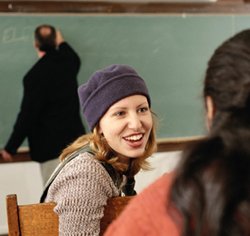The Physics of Teaching Physics

While most teachers and students were relaxing, a team of physicists spent their summer vacation modeling the physics of learning. They represented the interactions between students and teachers with a set of equations similar to those that describe magnetism in materials like iron. The results, which appear in the 10 September print issue of PRL, are consistent with data on student learning, but can equations convey the complexities of the classroom? Some educational specialists remain unconvinced.
To simulate the classroom environment, Clelia Bordogna and Ezequiel Albano of the Institute of Theoretical and Applied Physical Chemistry in La Plata, Argentina, used a so-called Ising model similar to those that describe magnetism in materials. According to the model, a classroom behaves a lot like a piece of iron: Individual students play the role of atoms, and their knowledge of a subject is similar the atoms’ magnetic orientations. The teacher behaves like an external magnetic field trying to align the student’s knowledge into the “right” direction (understanding the curriculum). But like the atoms in a chunk of iron, the students have other influences: Each student could influence her neighbor’s orientation, and social entropy, such as talking, passing notes, or obscure explanations, could cause the students to become disoriented.
The team’s model made several predictions that agree with data gathered in actual classrooms around the country. For example, when low-achieving and high-achieving students were interspersed in groups, they found that the low-achievers caught on more quickly. They also found that when students influenced each other through group work, they learned the material more thoroughly than when they simply listened to the teacher lecture.
But some educational specialists express skepticism of the study. “Classroom learning shouldn’t be boiled down into a mathematical formula,” said one educational researcher, adding that this kind of work could actually hurt the field by detracting from research on curriculum and teaching principles.
David Byrne, a sociologist who also studies chaos and complexity at the University of Durham in England, believes that trying to model education creates two problems. First, social interactions in the classroom often lack clear boundaries, which can make them difficult to model. Second, human behavior varies significantly, not only among individuals, but among classrooms and regions as well. Such variation, he believes, can throw off even the most general statistical models. Still, Byrne was pleased to see physicists trying to tackle the problem. “Simulations are always interesting–in the social sciences you can’t say much more than that,” he says. But twenty-five years ago, he adds, what would people have said about modeling of biology, economics, and ecology? All of which are commonplace today.
–Geoff Brumfiel


